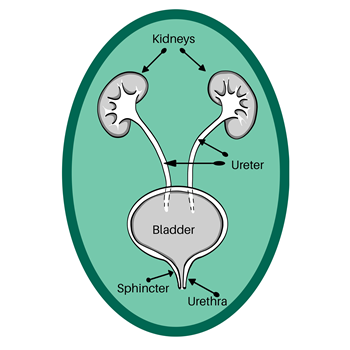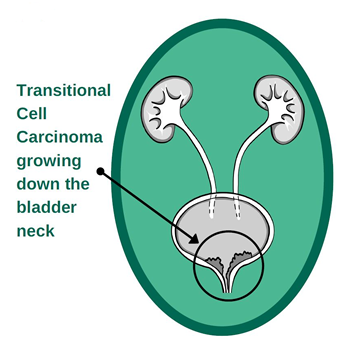There are a number of urinary related conditions that can develop in dogs. For many, the signs may appear similar.

Symptoms
- straining to urinate
- frequent urination
- blood in the urine
- urinating in abnormal places
- pain on urination
It is important to monitor your dog’s urination pattern closely and have your veterinarian examine your dog if you suspect a urinary issue.
The Urinary Tract
The urinary tract consists of the:
- kidneys
- ureters
- bladder
- urethra
Urinary Tract Infections

Bacteria are not normally found in the bladder, but when bacteria from the genital region enter the urethra and establish in the bladder, an infection and symptoms can develop.
Your dog may urinate more frequently and/or in smaller amounts, have blood-tinged urine, drink more, lick her vulva excessively, or urinate in areas other than her usual spot.
They can often be treated quickly and effectively using antibiotics following some urine-specific tests.
It is important to use the right antibiotic in infections of the bladder.
Bladder Stones (Urolithiasis)
Sometimes tiny minerals precipitate forming crystals in the bladder. These crystals are usually detectable in urine and sometimes even combine in large enough groups to form solid stones in the bladder.
Stones can also form in the kidneys, ureters or urethra however, the bladder is the most common location.
There are a variety of types of stones that can develop, each specific type forming under different bladder conditions, and some stones even developing more commonly in certain breeds of dogs.

Your dog may show signs of frequent urination, pain during urination or blood in the urine.
Due to the potential for stones to cause pain, obstruction, irritation/trauma and persistent UTIs, diagnosis and management are vital.
Bladder cancer (Transitional Cell Carcinoma)

A Transitional Cell Carcinoma (TCC) is a malignant tumour of the bladder.
Your dog may appear to strain when urinating or have bloody urine looking very similar to the signs of a UTI.
Prognosis depends on the stage of the disease, however as this cancer is malignant, long-term survival does not usually exceed more than 10 months.
Incontinence
Urinary incontinence is a relatively common condition seen in older desexed female dogs.
Ageing, obesity and reduced sensitivity of the neurologic receptors present around the bladder sphincter are also common contributors to this condition.
You may notice urine patches in your dog’s bed or floor, without seeing her actively try to urinate.
This condition is often diagnosed after ruling out more serious conditions and can be effectively managed with medicines.
Kidney Infection/Inflammation (Pyelonephritis)
Kidney infections develop when bacteria ascend up the bladder via the ureters, into the kidneys.
Your dog may get very sick with this disease and have increased urination and drinking, lethargy, go off their food and have vomiting. Your vet needs to be consulted immediately if these symptoms occur and appropriate antibiotics will need to be used to treat the infection.
Remember
It is important to monitor your dog’s urination pattern closely and have your veterinarian examine your dog if you suspect a urinary issue.
Trial
To ensure gold standards of care, select Greencross Vets clinics are participating in a research trial to investigate the most effective treatment available. You can contact one of the below clinics to learn more.
If you are seeing these symptoms in your pet please seek assistance from your nearest Greencross Vets clinic.
Article provided by Invetus.


 Greencross Vets
Greencross Vets 










